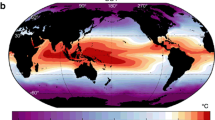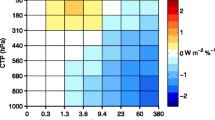Abstract
Recent general circulation model studies1–3 performed to assess the equilibrium climate response to doubling atmospheric CO2 suggested a global mean surface warming of 3.5–4.2 °C. Part of this warming was attributed to a change in cloud cover1. But all of these studies neglected changes of cloud optical properties which were shown to provide a substantial negative feedback in radiative-convective models if the cloud liquid water content was assumed to increase with increasing temperature4,5. This hypothesis is examined in a climate model where clouds are simulated interactively with dynamics, radiation and hydrological cycle6. The thermal forcing is introduced by a 2% increase of the solar constant which is equivalent to a doubling of CO21. The results show the anticipated increase of cloud liquid water and cloud optical depth. A feedback analysis of the simulated climate change supports earlier suggestions of the importance of cloud optical depth feedbacks4,5. The net effect of clouds is to provide a negative feedback on surface temperature, rather than the positive feedback found in earlier general circulation model studies without considering cloud optical depth feedbacks1.
Similar content being viewed by others
References
Hansen, J. E. et al. Geophys. Monogr. 29, 130–163 (1984).
Washington, W. M. & Meehl, G. A. J. geophys. Res. 89, 9475–9503 (1984).
Wetherald, R. T. & Manabe, S. Clim. Change 8, 5–23 (1986).
Charlock, T. P. Tellus 34, 245–254 (1982).
Somerville, R. C. J. & Remer, L. A. J. geophys. Res. 89, 9668–9672 (1984).
Roeckner, E. & Schlese, U. Proc. ECMWF Workshop on Cloud Cover Parameterization in Numerical Models, Reading, UK, 87–108 (European Centre for Medium Range Weather Forecasts, 1985).
Hense, A. et al. Q. Jl R. met. Soc. 108, 231–252 (1982).
Sundqvist, H. Q. Jl R. met Soc. 104, 677–690 (1978).
Braham, R. R. Jr Bull Am. met. Soc. 49, 343–353 (1968).
Stephens, G. L. J. atmos. Sci 35, 2123–2132 (1978).
Pollard, D. et al. J. phys. Oceanogr. 13, 754–768 (1983).
Schlesinger, M. E. Adv. Geophys. 26, 141–235 (1984).
Feigelson, E. M. Beitr. Phys. Atmos. 51, 203–229 (1978).
Wetherald, R. T. & Manabe, S. J. atmos. Sci. 37, 1485–1510 (1980).
Ohring, G. & Gruber, A. Adv. Geophys. 25, 237–304 (1983).
Oort, A. H. NOAA Prof. Paper No. 14 (1983).
Jaeger, L. Ber. Deut. Wetterdienstes, Offenbach 139, 1–38 (1976).
Stephens, G. L. et al. J. geophys. Res. 86, 9739–9760 (1981).
Walsh, J. E. & Johnson, C. M. J. phys. Oceanogr. 9, 580–590 (1979).
Zwally, H. J. et al. Science 220, 1005–1012 (1983).
Author information
Authors and Affiliations
Rights and permissions
About this article
Cite this article
Roeckner, E., Schlese, U., Biercamp, J. et al. Cloud optical depth feedbacks and climate modelling. Nature 329, 138–140 (1987). https://doi.org/10.1038/329138a0
Received:
Accepted:
Issue Date:
DOI: https://doi.org/10.1038/329138a0
- Springer Nature Limited
This article is cited by
-
Climate Sensitivity and Feedbacks of a New Coupled Model CAMS-CSM to Idealized CO2 Forcing: A Comparison with CMIP5 Models
Journal of Meteorological Research (2019)
-
Climate sensitivities of two versions of FGOALS model to idealized radiative forcing
Science China Earth Sciences (2014)
-
A comparison of climate feedbacks in general circulation models
Climate Dynamics (2003)
-
A comparison of SSM/I and TOVS column water vapor data over the global oceans
Meteorology and Atmospheric Physics (1994)
-
The hydrological cycle and its influence on climate
Nature (1992)





